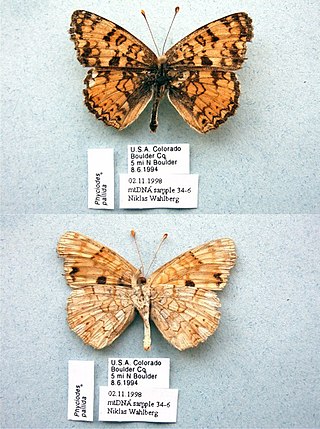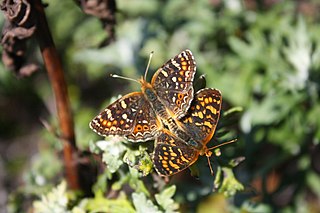
Rudbeckia hirta, commonly called black-eyed Susan, is a North American flowering plant in the family Asteraceae, native to Eastern and Central North America and naturalized in the Western part of the continent as well as in China. It has now been found in all 10 Canadian Provinces and all 48 of the states in the contiguous United States.

The pearl crescent is a butterfly of North America. It is found in all parts of the United States except the west coast, and throughout Mexico and parts of southern Canada, in particular Ontario. Its habitat is open areas such as pastures, road edges, vacant lots, fields, open pine woods. Its pattern is quite variable. Males usually have black antenna knobs. Its upperside is orange with black borders; postmedian and submarginal areas are crossed by fine black marks. The underside of the hindwing has a dark marginal patch containing a light-colored crescent.

Phyciodes batesii, the tawny crescent, is a butterfly of the family Nymphalidae that occurs in North America.

Phyciodes, the crescents or crescent spots is a genus of butterflies of the subfamily Nymphalinae in the family Nymphalidae.

Phyciodes pallida, the pale crescent or pallid crescentspot, is a species of butterfly in the family Nymphalidae. It is found in western North America.

Phyciodes mylitta, the Mylitta crescent or Mylitta crescentspot, is a butterfly of the family Nymphalidae. It is found in western North America.

Phyciodes pulchella, the field crescent, is a butterfly of the family Nymphalidae. It is found in the Nearctic realm.

Phyciodes phaon, the Phaon crescent or mat plant crescent, is a species of butterfly found in Florida, neighboring states, west to New Mexico and south to Cuba and the Cayman Islands where it is known as the crescent spot.

Phyciodes orseis, the Orseis crescentspot or California crescent, is a species of butterfly in the family Nymphalidae. It is found in western North America, particularly northern California and Oregon. Formerly, The range was thought to extend along the Coast Range as far south as San Francisco. However, they were either mislabeled or are currently extirpated from these regions. The habitat consists of mountain valleys, meadows and stream canyons. Along with roughly 120 other species, they are check-listed as butterflies occurring on or near the Fremont-Winema National Forests. This checklist has been established based on observations throughout Lake and Klamath counties in Oregon. The list is maintained by the Forest Service in order to monitor health of native ecosystems. Monitoring population levels of butterflies such as P. orseis over time provides a metric for these efforts. These pollinators play an integral role in such systems, as they are beneficial both for the flora of the region and as food sources for regional avian species.

Phyciodes picta, the painted crescent, is a species of crescents, checkerspots, anglewings, etc. in the butterfly family Nymphalidae. It is found in North America.

Phyciodes graphica, the vesta crescent, is a species of crescents, checkerspots, anglewings, etc. in the butterfly family Nymphalidae.













